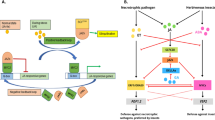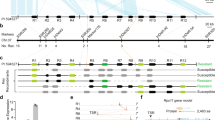Abstract
Diterpenoids are the major group of antimicrobial phytoalexins in rice1,2. Here, we report the discovery of a rice diterpenoid gene cluster on chromosome 7 (DGC7) encoding the entire biosynthetic pathway to 5,10-diketo-casbene, a member of the monocyclic casbene-derived diterpenoids. We revealed that DGC7 is regulated directly by JMJ705 through methyl jasmonate-mediated epigenetic control3. Functional characterization of pathway genes revealed OsCYP71Z21 to encode a casbene C10 oxidase, sought after for the biosynthesis of an array of medicinally important diterpenoids. We further show that DGC7 arose relatively recently in the Oryza genus, and that it was partly formed in Oryza rufipogon and positively selected for in japonica during domestication. Casbene-synthesizing enzymes that are functionally equivalent to OsTPS28 are present in several species of Euphorbiaceae but gene tree analysis shows that these and other casbene-modifying enzymes have evolved independently. As such, combining casbene-modifying enzymes from these different families of plants may prove effective in producing a diverse array of bioactive diterpenoid natural products.
This is a preview of subscription content, access via your institution
Access options
Access Nature and 54 other Nature Portfolio journals
Get Nature+, our best-value online-access subscription
$29.99 / 30 days
cancel any time
Subscribe to this journal
Receive 12 digital issues and online access to articles
$119.00 per year
only $9.92 per issue
Buy this article
- Purchase on Springer Link
- Instant access to full article PDF
Prices may be subject to local taxes which are calculated during checkout




Similar content being viewed by others
Data availability
The sequences data of 424 O. sativa accessions are available in the National Center for Biotechnology Information (NCBI) under the BioProject PRJNA171289 (ref. 17). The single nucleotide polymorphisms information of 424 O. sativa accessions is available in RiceVarMap (http://ricevarmap.ncpgr.cn/v1). The pangenome data were acquired from the pangenome dataset (https://figshare.com/collections/Novel_sequences_structural_variations_and_gene_presence_variations_of_Asian_cultivated_rice/3876022/1 and http://cgm.sjtu.edu.cn/3kricedb/)18,19,24. Thirteen accessions of O. rufipogon were selected from 446 diverse O. rufipogon accessions from Asia and Oceania, and represented all the major genetically distinct clusters in O. rufipogon; the other ten wild rice are from EnsemblPlants (http://plants.ensembl.org/index.html) and National Genomics Data Center (https://bigd.big.ac.cn/search?dbId=gwh&q=Oryza), including O. barthii (AA), O. glumipatula (AA), O. glaberrima (AA), O. meridionalis (AA), O. longistaminata (AA), O. nivara (AA), O. brachyantha (FF), O. punctata (BB) and O. brachyantha (GG)24. Genes reported in the study are deposited in the NCBI. The genes can be found in GenBank or Rice Genome Annotation Project database (http://rice.plantbiology.msu.edu/analyses_search_locus.shtml) under the following accession numbers: OsTPS28, MN833254; OsCYP71Z21, LOC_Os07g11870; OsCYP71Z2, LOC_Os07g11739; OsCYP71Z22, LOC_Os07g11970; OsCYP71Z30, LOC_Os07g11890. Source data are provided with this paper.
Change history
16 December 2020
A Correction to this paper has been published: https://doi.org/10.1038/s41477-020-00838-1.
References
Schmelz, E. A. et al. Biosynthesis, elicitation and roles of monocot terpenoid phytoalexins. Plant J. 79, 659–678 (2014).
Lu, X. et al. Inferring roles in defense from metabolic allocation of rice diterpenoids. Plant Cell 30, 1119–1131 (2018).
Li, T. et al. Jumonji C domain protein JMJ705-mediated removal of histone H3 lysine 27 trimethylation is involved in defense-related gene activation in rice. Plant Cell 25, 4725–4736 (2013).
Chen, X. et al. Biological activities and potential molecular targets of cucurbitacins: a focus on cancer. Anti-Cancer Drug 23, 777–787 (2012).
Huang, A. C. et al. A specialized metabolic network selectively modulates Arabidopsis root microbiota. Science 364, eaau6389 (2019).
Nützmann, H.-W., Huang, A. & Osbourn, A. Plant metabolic clusters—from genetics to genomics. New Phytol. 211, 771–789 (2016).
Zi, J., Mafu, S. & Peters, R. J. To gibberellins and beyond! Surveying the evolution of (di)terpenoid metabolism. Annu. Rev. Plant Biol. 65, 259–286 (2014).
Panizza, B. J. et al. Phase I dose-escalation study to determine the safety, tolerability, preliminary efficacy and pharmacokinetics of an intratumoral injection of tigilanol tiglate (EBC-46). EBioMedicine 50, 433–441 (2019).
Hezareh, M. Prostratin as a new therapeutic agent targeting HIV viral reservoirs. Drug News Perspect. 18, 496–500 (2005).
Johnson, H. E., Banack, S. A. & Cox, P. A. Variability in content of the anti-AIDS drug candidate prostratin in Samoan populations of Homalanthus nutans. J. Nat. Prod. 71, 2041–2044 (2008).
Lebwohl, M. et al. Ingenol mebutate gel for actinic keratosis. N. Engl. J. Med. 366, 1010–1019 (2012).
Sabandar, C. W., Ahmat, N., Jaafar, F. M. & Sahidin, I. Medicinal property, phytochemistry and pharmacology of several Jatropha species (Euphorbiaceae): a review. Phytochemistry 85, 7–29 (2013).
Inoue, Y. et al. Identification of a novel casbane-type diterpene phytoalexin, ent-10-oxodepressin, from rice leaves. Biosci. Biotech. Biochem. 77, 760–765 (2013).
Horie, K., Sakai, K., Okugi, M., Toshima, H. & Hasegawa, M. Ultraviolet-induced amides and casbene diterpenoids from rice leaves. Phytochem. Lett. 15, 57–62 (2016).
Li, W. et al. OsCYP71Z2 involves diterpenoid phytoalexin biosynthesis that contributes to bacterial blight resistance in rice. Plant Sci. 207, 98–107 (2013).
Li, W. et al. Overexpressing CYP71Z2 enhances resistance to bacterial blight by suppressing auxin biosynthesis in rice. PLoS ONE 10, e0119867 (2015).
Zhao, H. et al. RiceVarMap: a comprehensive database of rice genomic variations. Nucleic Acids Res. 43, D1018–D1022 (2015).
Wang, W. et al. Genomic variation in 3,010 diverse accessions of Asian cultivated rice. Nature 557, 43–49 (2018).
Huang, X. et al. A map of rice genome variation reveals the origin of cultivated rice. Nature 490, 497–501 (2012).
Chen, W. et al. Genome-wide association analyses provide genetic and biochemical insights into natural variation in rice metabolism. Nat. Genet. 46, 714–721 (2014).
Yu, N. et al. Delineation of metabolic gene clusters in plant genomes by chromatin signatures. Nucleic Acids Res. 44, 2255–2265 (2016).
Zhou, S. et al. Cooperation between the H3K27me3 chromatin mark and non-CG methylation in epigenetic regulation. Plant Physiol. 172, 1131–1141 (2016).
Nützmann, H.-W. et al. Active and repressed biosynthetic gene clusters have spatially distinct chromosome states. Proc. Natl Acad. Sci. USA 24, 13800–13809 (2020).
Stein, J. C. et al. Genomes of 13 domesticated and wild rice relatives highlight genetic conservation, turnover and innovation across the genus Oryza. Nat. Genet. 50, 285–296 (2018).
Wing, R. A., Purugganan, M. D. & Zhang, Q. The rice genome revolution: from an ancient grain to green super rice. Nat. Rev. Genet. 19, 505–517 (2018).
King, A. J., Brown, G. D., Gilday, A. D., Larson, T. R. & Graham, I. A. Production of bioactive diterpenoids in the Euphorbiaceae depends on evolutionarily conserved gene clusters. Plant Cell 26, 3286–3298 (2014).
Takos, A. M. et al. Genomic clustering of cyanogenic glucoside biosynthetic genes aids their identification in Lotus japonicus and suggests the repeated evolution of this chemical defence pathway. Plant J. 68, 273–286 (2011).
Field, B. & Osbourn, A. E. Metabolic diversification—independent assembly of operon-like gene clusters in different plants. Science 320, 543–547 (2008).
Wang, M. et al. Parallel selection on a dormancy gene during domestication of crops from multiple families. Nat. Genet. 50, 1435–1441 (2018).
Swaminathan, S., Morrone, D., Wang, Q., Fulton, D. B. & Peters, R. J. CYP76M7 is an ent-cassadiene C11-hydroxylase defining a second multifunctional diterpenoid biosynthetic gene cluster in rice. Plant Cell 21, 3315–3325 (2009).
Wang, Q., Hillwig, M. L. & Peters, R. J. CYP99A3: functional identification of a diterpene oxidase from the momilactone biosynthetic gene cluster in rice. Plant J. 65, 87–95 (2011).
Wang, Q. et al. Characterization of CYP76M5-8 indicates metabolic plasticity within a plant biosynthetic gene cluster. J. Biol. Chem. 287, 6159–6168 (2012).
Miyamoto, K. et al. Evolutionary trajectory of phytoalexin biosynthetic gene clusters in rice. Plant J. 87, 293–304 (2016).
Gross, B. L. & Zhao, Z. Archaeological and genetic insights into the origins of domesticated rice. Proc. Natl Acad. Sci. USA 111, 6190–6197 (2014).
Qi, Z. Genetics and improvement of bacterial blight resistance of hybrid rice in China. Rice Sci. 23, 111–119 (2009).
Kauffman, H. E., Reddy, A. P. K., Hsieh, S. P. Y. & Merca, S. D. An improved technique for evaluating resistance of rice varieties to Xanthomonas oryzae. Plant Dis. Rep. 57, 537–541 (1973).
Zhang, H. et al. Transposon-derived small RNA is responsible for modified function of WRKY45 locus. Nat. Plants 2, 16016 (2016).
Zhang, B. et al. Multiple alleles encoding atypical NLRs with unique central tandem repeats in rice confer resistance to Xanthomonas oryzae pv. oryzae. Plant Commun. 1, 100088 (2020).
Tao, Z. et al. A pair of allelic WRKY genes play opposite roles in rice–bacteria interactions. Plant Physiol. 151, 936–948 (2009).
King, A. J. et al. A cytochrome P450-mediated intramolecular carbon–carbon ring closure in the biosynthesis of multidrug-resistance-reversing lathyrane diterpenoids. ChemBioChem 17, 1593–1597 (2016).
Boutanaev, A. M. et al. Investigation of terpene diversification across multiple sequenced plant genomes. Proc. Natl Acad. Sci. USA 112, E81–E88 (2015).
Luo, D. et al. Oxidation and cyclization of casbene in the biosynthesis of Euphorbia factors from mature seeds of Euphorbia lathyris L. Proc. Natl Acad. Sci. USA 113, E5082–E5089 (2016).
Peng, M. et al. Differentially evolved glucosyltransferases determine natural variation of rice flavone accumulation and UV-tolerance. Nat. Commun. 8, 1975 (2017).
Ikezawa, N. et al. Lettuce costunolide synthase (CYP71BL2) and its homolog (CYP71BL1) from sunflower catalyze distinct regio- and stereoselective hydroxylations in sesquiterpene lactone metabolism. J. Biol. Chem. 286, 21601–21611 (2011).
Sainsbury, F., Thuenemann, E. C. & Lomonossoff, G. P. pEAQ: versatile expression vectors for easy and quick transient expression of heterologous proteins in plants. Plant Biotechnol. J. 7, 682–693 (2009).
Zeng, X. et al. Genome-wide dissection of co-selected UV-B responsive pathways in the UV-B adaptation of qingke. Mol. Plant 13, 112–127 (2020).
Acknowledgements
We thank J. D. Keasling, G. P. Lomonossoff and Z. Zhao for their advice and their gift of the expression vectors and strains. We also thank D. R. Nelson, University of Tennessee, for help in naming the OsCYP71Z30. This work was supported by the National Science Fund for Distinguished Young Scholars (grant no. 31625021), the State Key Programme of National Natural Science Foundation of China (grant no. 31530052) and the Hainan University Startup Fund KYQD(ZR)1866 to J.L.
Author information
Authors and Affiliations
Contributions
J.L. designed the research. J.L., L.-L.C., L.Q., M.Y. and X.L. supervised this study. C.Z., L. Lei, S.Z., Z.L., F.Z., M.Z., Y. Sun, Y. Shi, K.L., T.C., M.H., I.G., Z.Y. and T.T. participated in the material preparation. C.Z., C.Y., Yi Li, X.W. and J.S. carried out the metabolite analyses. C.Z., Z.L., S.Z., C.Y., X.Z., H.G., M.P., M.Z., Yufei Li, Z.Y., L. Liu, S.S., J.S., X.J., Yi Li, T.T. and Z.W. performed the data analyses. C.Z., L. Lei, Z.L., S.Z. and C.Y. performed most of the experiments. J.L., C.Z., I.G. and A.R.F. wrote the manuscript.
Corresponding author
Ethics declarations
Competing interests
The authors declare no competing interests.
Additional information
Peer review information Nature Plants thanks the anonymous reviewers for their contribution to the peer review of this work.
Publisher’s note Springer Nature remains neutral with regard to jurisdictional claims in published maps and institutional affiliations.
Extended data
Extended Data Fig. 1 The distribution of the worldwide collection of rice accessions in this study.
The core collection of 424 cultivated rice accessions in this study has a wide geographic distribution. Colour dots indicate different subspecies/type of cultivated rice.
Extended Data Fig. 2 Functional analyses of OsTPS28, OsCYP71Z2 and OsCYP71Z21.
a, Gas chromatography of the reaction products of OsTPS28 with GGDP. GGDP, geranylgeranyl diphosphate. Casbene and neocembrene reference compounds were purified from infiltrated N. benthamiana leaves by the method described previously26. Compound 1, casbene; Compound 2, neocembrene. b, Gas chromatography of in vitro enzyme assays showing the 10-keto-casbene C5 oxidase activity of yeast-expressed CYP71Z2 in the present of NADPH. Microsomes prepared from yeast containing PESC-URA empty vector were used as a negative control. 10-keto-casbene reference compound was purified from rice leaves by the method described previously13,14. Compound 3, 10-keto- casbene; Compound 4, 5,10-diketo-casbene. c, Gas chromatography of the extracts prepared from the leaves of N. benthamiana infiltrated with OsTPS28 overexpressing vector.
Extended Data Fig. 3 Mass spectrum and structure of 5,10- diketo-casbene.
a, Mass spectrum and structure of the product in N. benthamiana leaves simultaneously overexpressing OsTPS28, OsCYP71Z2 and OsCYP71Z21. b, Mass spectrum of 5,10-diketo-casbene reference. LC-MS, liquid chromatography–mass spectrometry. c, 1H NMR (left) and 13C NMR (right) results of 5,10-diketo-casbene.
Extended Data Fig. 4 The expression profiles of genes from DGC7.
The genes from DGC7 are indicated in bold. The transcript abundances of indicated genes in different organs at different stages were shown: expression levels of OsTPS28, OsCYP17Z2 and OsCYP71Z21 is correlated at different developmental stages. The numerical values for blue-to-red gradient represent normalized expression levels from quantitative real-time PCR analysis.
Extended Data Fig. 5 The casbene-type diterpene biosynthesis via distinct biosynthetic routes in rice and castor.
The casbene-type diterpene biosynthetic pathways in rice and castor. Chr.7, chromosome 7; GGDP, geranylgeranyl diphosphate.
Supplementary information
Supplementary Information
Supplementary Methods, Figs. 1–16 and references.
Supplementary Tables
Supplementary Tables 1–10.
Source data
Source Data Fig. 1
Statistical source data.
Source Data Fig. 3
Statistical source data.
Rights and permissions
About this article
Cite this article
Zhan, C., Lei, L., Liu, Z. et al. Selection of a subspecies-specific diterpene gene cluster implicated in rice disease resistance. Nat. Plants 6, 1447–1454 (2020). https://doi.org/10.1038/s41477-020-00816-7
Received:
Accepted:
Published:
Issue Date:
DOI: https://doi.org/10.1038/s41477-020-00816-7
This article is cited by
-
Alternative polyadenylation profiles of susceptible and resistant rice (Oryza sativa L.) in response to bacterial leaf blight using RNA-seq
BMC Plant Biology (2024)
-
Characterization of novel loci controlling seed oil content in Brassica napus by marker metabolite-based multi-omics analysis
Genome Biology (2023)
-
A syntelog-based pan-genome provides insights into rice domestication and de-domestication
Genome Biology (2023)
-
Characterization of the horse chestnut genome reveals the evolution of aescin and aesculin biosynthesis
Nature Communications (2023)
-
Plant immune inducer ZNC promotes rutin accumulation and enhances resistance to Botrytis cinerea in tomato
Stress Biology (2023)



